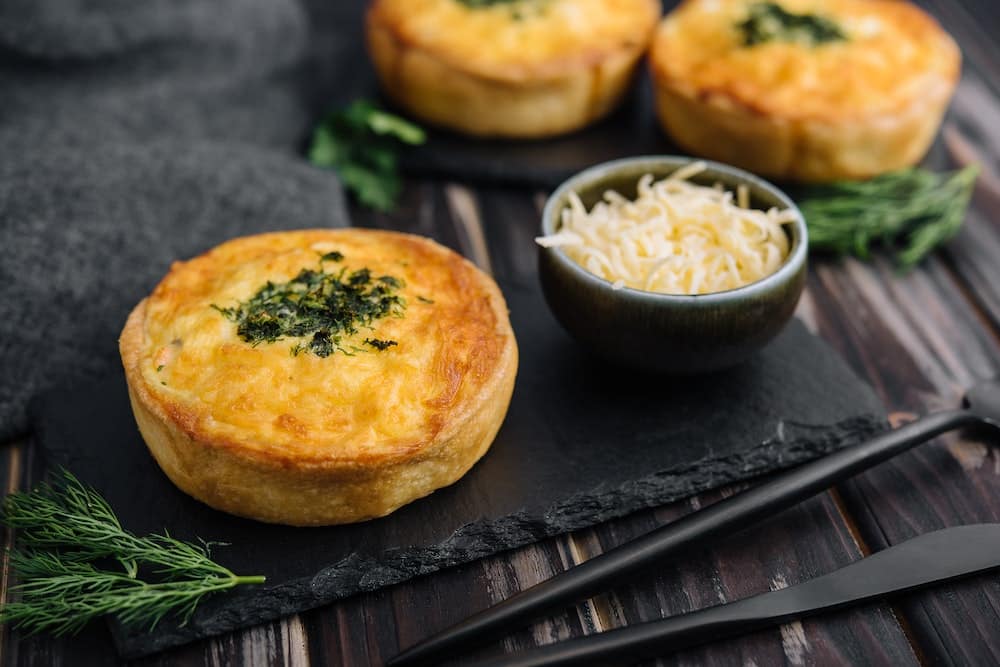Quiche is an elegant, versatile dish. A staple in French cuisine, quiche can be served for breakfast, brunch, lunch or dinner. The star of the show is Quiche Lorraine, brimming with cheese and bacon, nestled in a buttery, flaky crust. But can you pull off this gourmet dish at home? The answer is a resounding yes!
With a touch of patience, a pinch of skill, and a dash of time, the seemingly intricate Quiche Lorraine can be made right in your kitchen. And in this article,
we’re going to do just that, we’ll take you on a gastronomic adventure and break down the process of making a gourmet Quiche Lorraine with a buttery, flaky crust.
Also to read : How to Make a Perfect Spanish Tortilla de Patatas with a Creamy Center?
Crafting the Perfect Dough for a Buttery, Flaky Crust
The foundation of any good quiche is the crust. It serves as the vessel that holds the filling and delivers the palate a symphony of tastes and textures.
Start by assembling your ingredients. Making pie crust requires only a few simple items: flour, salt, cold butter, and ice water. The butter is the essential ingredient here that gives the crust its rich, buttery flavor and flaky texture.
Have you seen this : How to Achieve the Perfect Chew in Homemade Bagels with a Malty Boil?
The process begins by mixing the flour and salt together in a large bowl. Then, cut in the cold butter until it’s about the size of peas. Slowly add ice water, one tablespoon at a time, until the dough comes together. This may take some time, but be patient.
Next, is the chilling process. Shape the dough into a disk, wrap it in plastic wrap and refrigerate for at least one hour. This will help the butter to solidify, leading to that desired flaky result.
Roll, Fit, and Chill the Dough in Your Pan
After your dough has chilled, it’s time to roll it out and fit it into your pie pan. Lightly flour your surface and roll out your dough until it’s about 12 inches in diameter. Carefully lift the dough and place it in your pie pan, pressing it down into the corners. Trim any excess dough and crimp the edges.
Once your dough is fitted into the pan, it needs to chill again. This will prevent the crust from shrinking when you bake it. So, place your pan in the fridge for another 30 minutes.
Blind Bake Your Pie Crust
Blind baking is a technique where the pie crust is pre-baked before the filling is added. This ensures that your crust is fully cooked and doesn’t get soggy from the filling.
First, line your chilled crust with parchment paper, then fill it with pie weights or dried beans. Bake it in a preheated oven at 375 degrees for about 20 minutes. Then, carefully remove the weights and parchment, and bake for another 10 minutes until the crust is golden brown.
Making the Quiche Lorraine Filling
The Quiche Lorraine filling is a savory custard composed of eggs, cream, cheese, and bacon. Start by sautéing chopped bacon until it’s crispy. Then drain the excess fat.
In a separate bowl, whisk together eggs, cream, and a pinch of salt. The proportion of eggs to cream is crucial for a silky, not-too-eggy custard. The rule of thumb is one large egg for every half cup of cream. Add grated cheese, traditionally Gruyère or Swiss, to your custard mixture. Then stir in your crispy bacon.
Assemble and Bake the Quiche Lorraine
Now you’re ready to assemble your Quiche Lorraine. Pour your filling into your partially baked crust. Then return your quiche to the oven.
Bake at 375 degrees for 35-40 minutes, until the filling is set and the top is lightly browned. If you notice the crust browning too much during baking, you can cover it with a pie shield or some aluminum foil.
There you have it. You’ve made a gourmet Quiche Lorraine. With practice, you will find that making quiche isn’t as intimidating as it may seem, and the result is a flavorful, satisfying dish that’s perfect for any meal. So roll up your sleeves, grab your baking tools, and get ready to dazzle your taste buds with this truly delicious dish.
Making a Gluten-Free Quiche Lorraine
For those with dietary restrictions, altering the classic quiche Lorraine recipe to be gluten-free is an easy task without compromising on the taste or texture. The trick here lies in the quiche crust.
A gluten-free crust can be made using a combination of gluten-free flour and almond flour, maintaining the necessary flaky texture. The process remains the same – combine the flours with salt, cut in the cold butter, and slowly add ice water. Chill the dough as you would in a regular crust recipe and voila, you have a gluten-free pie crust.
When it comes to the filling, the base ingredients for a quiche Lorraine remain the same: eggs, heavy cream, cheese, and bacon. The ratios remain the same in a gluten-free version.
After rolling out the dough and fitting it in your quiche pan, allow it to chill. Follow the same process of blind baking your crust, creating a golden-brown shell for your filling. Assemble your quiche with the egg mixture and bake.
The result is a delicious, gluten-free quiche Lorraine that can be enjoyed by everyone, without compromising on taste or texture.
Troubleshooting Your Quiche Lorraine
In the process of making a quiche recipe, you may encounter some common issues. Here are a few tips to help you avoid them.
If your quiche is soggy, it may be because your crust is undercooked. Ensure that you blind bake it properly. If your quiche is weeping, it means the eggs are overcooked. To avoid this, make sure to remove your quiche from the oven when the center is still slightly wobbly.
If you find your crust is browning too quickly while the filling is still undercooked, you can use a pie shield or a piece of aluminum foil to protect it. Another possible issue is the crust shrinking or puffing up during the blind bake. To avoid this, make sure to chill the crust before baking and use pie weights or dried beans to keep the crust in shape.
Wrapping It Up
Making a gourmet quiche Lorraine with a buttery, flaky crust is not as difficult as it might initially seem. With just a handful of ingredients and a bit of time, you can create this classic French dish right in your own kitchen.
Whether you’re sticking to the traditional recipe or making a gluten-free version, the result is a rich, savory dish that’s perfect for any meal. And remember, practice makes perfect. The more you make a quiche, the better you’ll become at it.
So don’t be intimidated. Roll up your sleeves, dust off your rolling pin, and get ready to impress your friends and family with your culinary skills. Bon appétit!











